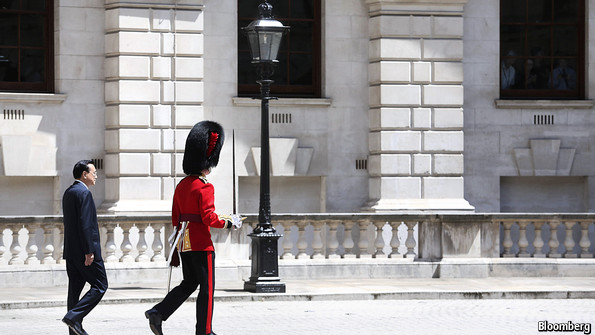THE ECONOMIST Jun 21st 2014 | HONG KONG | (Click here to original new)
Buzz about the rise of China’s currency has run far ahead of sedate reality

IF HEADLINES translated into trading volumes, the yuan would
be well on its way to dominating the world’s currency markets. It once
again graced front pages this week after moves to lift its status in
London, the world’s biggest foreign-exchange market. This was the latest
instalment of a five-year-long public-relations campaign. Since 2009,
when China first declared its intention to promote the yuan
internationally, a string of announcements and milestones has cast the
Chinese currency as a putative rival to the dollar.
The hype rests on several seemingly impressive numbers. Yuan
deposits beyond China’s borders have increased tenfold in the past five
years. The “dim sum” bond market for yuan-denominated debt issued
outside China has gone from non-existence to a dozen issuances a month.
And the yuan is the second-most-used currency in the world for trade
finance.
Adding to the impression that something big is afoot is the competition
between cities around the world to establish themselves as yuan-trading
hubs. London puffed up its chest this week after the Chinese government
designated China Construction Bank as the official clearing bank for
yuan-denominated transactions in Britain and agreed to launch direct
trading between the pound and the yuan in China. These announcements
were made to coincide with a trip to London by Li Keqiang, China’s prime
minister (pictured above).
The designation of a clearing bank creates a channel for
yuan held in Britain to flow into Chinese capital markets, boosting
London’s appeal as a trading centre for the currency. Other cities such
as Frankfurt and Singapore have also been awarded clearing banks, but
London already controls nearly 60% of yuan-denominated trade payments
between Asia and Europe, and this week’s agreement will shore up its
position.
London’s currency traders, however, will not be
hyperventilating. The rapid growth in the use of the yuan outside China,
whether for trade settlement or investment, has been from a minuscule
base. The yuan is the seventh-most-used currency in international
payments, according to SWIFT, a global transfer system. That is up from
20th place at the start of 2012. However, the Chinese currency still
accounts for a mere 1.4% of global payments, compared with the dollar’s
42.5%. Given that many of those deals just shuffle cash between Chinese
companies and their subsidiaries in Hong Kong, there is much less than
meets the eye to the yuan’s stature as a trade-settlement currency.
Even more telling is the yuan’s standing as an investment
currency. The dollar’s biggest selling point as a global reserve
currency is the deep, liquid pool of American assets open to
international buyers. Despite the barrage of reports in recent years
about the dim-sum bond market, China’s offerings are much sparser.
Jonathan Anderson of Emerging Advisors Group calculates that global
investors have access to $56 trillion of American assets, including
bonds and stocks. They can also get their hands on $29 trillion of
euro-denominated assets and $17 trillion of Japanese ones. But when it
comes to Chinese assets, just $0.3 trillion or so are open to foreign
investors. This puts the yuan on a par with the Philippine peso and a
bit above the Peruvian nuevo sol, Mr Anderson notes.
What is holding the yuan back? The answer is China
itself—both by circumstance and, more importantly, by design. For a
currency to go global, there has to be a path for it to leave its
country of origin. The easiest route is via a trade deficit. For
example, since the United States imports more than it exports, it in
effect adds to global holdings of dollars on a daily basis. That does
not work for China, which almost always runs a large trade surplus. It
has tried to solve this problem by offering to pay for imports in yuan,
while still accepting dollars for its exports.
Yet this approach can go only so far, because of the design
of the Chinese system. Foreigners paid in yuan cannot do much with the
currency and thus look askance at it. China could change this at a
stroke by flinging open its capital account. There is speculation that
it might do just that as debate about financial reform intensifies in
Beijing. But Yu Yongding, a former adviser to the central bank, predicts
that caution will prevail, with the government slowly lowering its wall
of capital controls rather than demolishing it. That would be far
better for China’s financial stability. But it also means that the chasm
between the hype about the yuan and the mundane reality is likely to
widen.

No comments:
Post a Comment